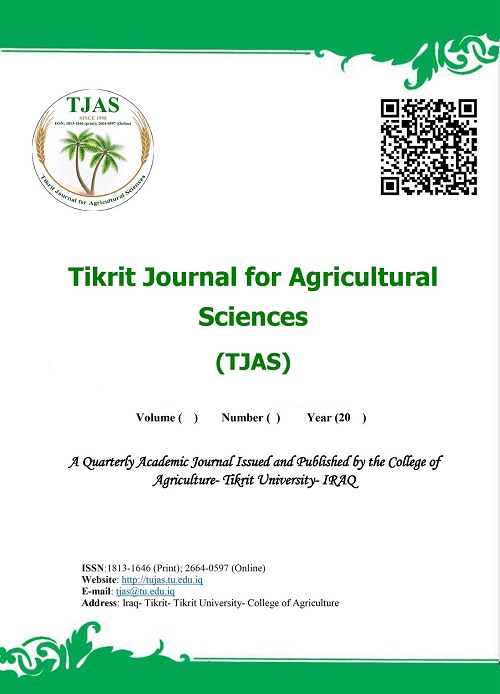Abstract
A field experiment was conducted in Autumn season of 2013, to aim determinate the best moisture content for picking the ear of maize. The experiment was applyied for to compare between the varieties (Taler, Messerra, Al-eizz and Bouhouth 106). This experiment was conducted as split-plot by a randomized complete block design with three replicates. The genotypes were assigned in the main plot, the moisture ratios (26, 28, 30 and 32%) were in sub plots. The statistical analysis for the experiment resulted to be significant differences in all studied traits by genotypes in the experiment. Taller was surpassed in the ear weight (260.7g) , trash materials ratio threshing (14.37%), oil ratio (9.40%) , embryo to the seed ratio (65.25 %) and field growing ratio (94.8%) . Bouhouth 106 was surpassed in 300 grains weight (291g) and protein ratio (10.42%). Al-eizz was surpassed in the starch ratio (32.04%).The results showed significant difference for moisture content for ears at the harvest in most studied traits. The lowest moisture content (26%) gave highest ratio of not broken (good) seeds (92.78%) and highest ratio of trash materials (7.22%) and gave heights oil ratio (7.08%), protein ratio (9.22%) and filed growing ratio (92.7%). The harvested ears were gave at higher moisture content (32%) gave highest bulk density (808.1 kg.m-3) and highest trash materials ratio (7.22%, and it gave lowest good broken seeds after threshing mechanically (85.09%), oil ratio (6.35%), protein ratio (9.22%) and filed growing ratio (89.4%). The experiment analysis, of correlation showed there was positive correlation relation with high significant between the qualitative traits for the seeds of the studied varieties there was also negative correlation relation with significant between the weight of the ear and not broken (good) seeds ratio which resulted from mechanical threshing (-0.685). There was also positive correlation between the pith to ear ratio and trash materials ratio (0.642%), also the results showed there was also positive correlation to the filed growing, weight of the seed , bulk density and ratio of embryo to the seed (0.714, 0.612 and 0.569) respectively.
Keywords
Maize
moisture ratios
Seed quality
Abstract
نفذت تجربة حقلية في الموسم الخريفي لعام 2013 ، بهدف تحديد انسب رطوبة يمكن عندها قطف العرنوص لأربعة اصناف من الذرة الصفراء. استعمل تصميم القطاعات الكاملة المعشاة بترتيب الالواح المنشقة بثلاث مكررات . شغلت الاصناف (تالار ومسرة والعز وبحوث 106) . الالواح الرئيسية ، بينما شغلت نسبة الرطوبة (26 و28 و30 و32%) الالواح الثانوية. اشارت النتائج الى وجود تأثير للتراكيب الوراثية في جميع الصفات المدروسة. اذ تفوق الصنف تالار في وزن العرنوص (260.7 غم) ونسبة المواد الخاملة (14.37%) وفي نسبة الزيت (9.40%) ونسبة الجنين الى البذرة (65.25%) ونسبة البزوغ الحقلي (94.8%)، في حين تفوق الصنف 106 في وزن الحبة (291غم) ونسبة البروتين (10.42%) ، وتفوق الصنف العز بنسبة النشا (32.04%). واظهرت النتائج وجود تأثير معنوي للمحتوى الرطوبي على اغلب الصفات المدروسة ، فقد اعطى المحتوى الرطوبي (26%) اعلى نسبة للحبوب السليمة والمواد الخاملة (92.78 و7.22%) بالتتابع ، واعلى متوسط لمحتوى البذور من الزيت والبروتين ونسبة البزوغ الحقلي (7.08 و 9.22 و92.7%) بالتتابع . ، بينما اعطى المحتوى الرطوبي 32% اعلى نسبة للمواد الخاملة والكثافة الظاهرية (7.22% و 808.1 كغم. م-1 ) بالتتابع ، والذي اعطى ادنى متوسط للحبوب السليمة (85.09%) وادنى متوسط لنسب البروتين والزيت والبزوغ الحقلي (9.22 و6.35 و89.4%). اظهرت نتائج تحليل الارتباط البسيط وجود علاقة ارتباط موجبة عالية المعنوية بين الصفات النوعية لبذور الأصناف المدروسة ، كما وجدت علاقة ارتباط سالبة معنوية بين وزن العرنوص ونسبة البذور السليمة الناتجة من التفريط الميكانيكي (0.685-) ، كما أظهرت النتائج وجود علاقة ارتباط موجبة للبزوغ الحقلي ووزن الحبة والكثافة الظاهرية ونسبة الجنين للبذرة (0.714 و0.612 و0.569) بالتتابع.
Keywords
ذرة صفراء ، نسب الرطوبة ، الصفات النوعية
